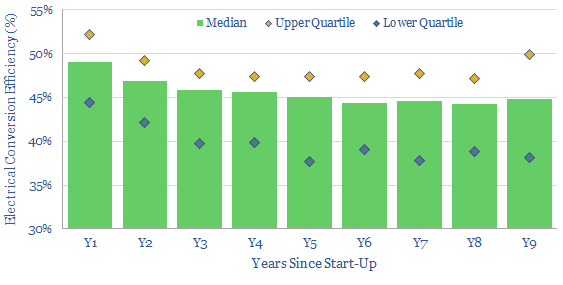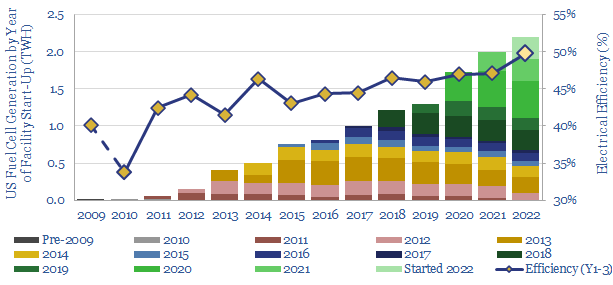This data-file captures the performance of c160 fuel cell power plants, installed to-date in the US, generating over 2TWH per year of electricity, looking facility-by-facility, year-by-year. How has the performance, efficiency and longevity of US fuel cell power plants been trending over time?
This data-file aggregates electricity production and fuel consumption from 160 fuel cell power plants installed to-date in the United States, which generated over 2 TWH pa of electricity in 2022, and can be compared with our 13,000 TWH US energy model here.
Where are US fuel cell power plants located? Out of the US’s total c2 TWH pa of fuel cell power generation, c50% is in California (home to Bloom Energy, a leader in solid oxide fuel cells), and c20% is in Connecticut (home to Fuel Cell Energy, making solid oxide and molten carbonate fuel cells).
How are today’s fuel cells powered? To date, over 90% of US fuel cell power plants have been powered by natural gas. As part of the energy transition, many commentators are hoping to use fuel cells to convert green hydrogen back into electricity. Although in our view, this is the thermodynamic equivalent of printing out your emails. Our hydrogen conclusions are summarized here.
What is the electrical efficiency of fuel cells installed historically in the US? As a median, across all of our data, the average fuel cell installed in the US has achieved an electrical efficiency of 46%. This is above the electrical efficiency of coal plants which average 38%. Simple cycle gas turbines achieve 40%, rising to 57% for the average combined cycle plant (data here). All of these numbers can vary, plant by plant, and over time (chart below).

What is the average capacity of a fuel cell power plant? The average capacity of a fuel cell power plant is around 2MW, based on the data in our database. This is relevant because it is small-scale (power plant sizes are tabulated here). Generally smaller-scale gas turbines are materially less efficient than the 40-57% quoted above, and maybe closer to 15-30%.
Where are fuel cells best suited? Fuel cells may be best suited to environments that wish to supplement grid power with self-generation, at small scales, where existing gas turbines may not be as efficient, and especially where waste heat can be used. For comparison, our research into CHPs is summarized here.
What is the biggest challenge for fuel cells? The biggest challenges for fuel cells are their high capex costs (modeled here and here) and their longevity and reliability. The average fuel cell power plant in our database has seen its annual output decline at 5% per year. Looking facility-by-facility also allows us to quantify the typical lifespan of a fuel cell power plant. The average lifespan of the first generation of US fuel cell power plants has been around 10-years.
Has the performance of fuel cells been improving over time? In our view this is the most interesting and important question for the future of fuel cells. The data-file contains our conclusions on the rate of improvements in electrical efficiency and reliability/longevity.
A subset of the data is split out for Bloom Energy, the leading manufacturer of Solid Oxide Fuel Cells, which operates 30% of all fuel cells in the US. The data allow us to quantify whether Bloom Energy’s fuel cells have higher efficiency or higher longevity than the industry average. Other leading companies in fuel cells are screened here, based on evaluating their patent filings.

